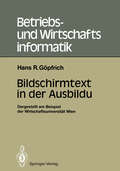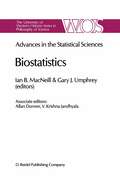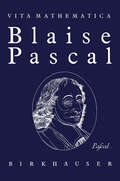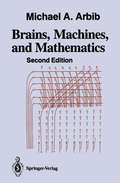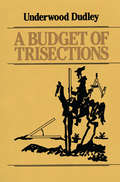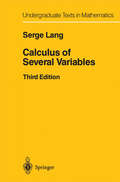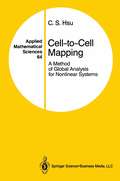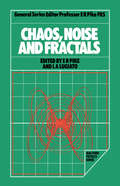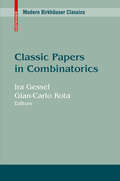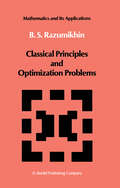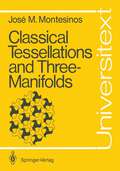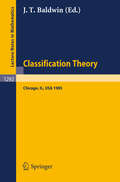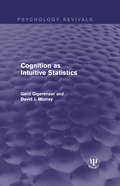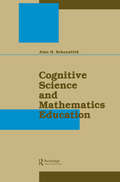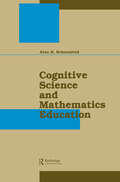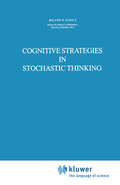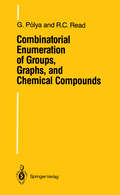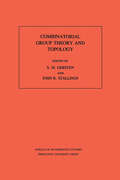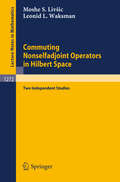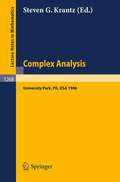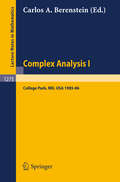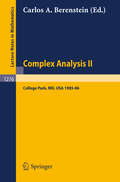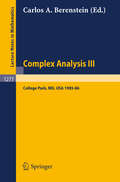- Table View
- List View
Bildschirmtext in der Ausbildung: Dargestellt am Beispiel der Wirtschaftsuniversität Wien (Betriebs- und Wirtschaftsinformatik #18)
by Hans Rudolf GöpfrichBiostatistics: Advances in Statiscal Sciences Festschrift in Honor of Professor V.M. Joshi’s 70th Birthday Volume V (The Western Ontario Series in Philosophy of Science #38)
by I. B. MacNeill G. UmphreyOn May 27-31, 1985, a series of symposia was held at The University of Western Ontario, London, Canada, to celebrate the 70th birthday of Pro fessor V. M. Joshi. These symposia were chosen to reflect Professor Joshi's research interests as well as areas of expertise in statistical science among faculty in the Departments ofStatistical and Actuarial Sciences, Economics, Epidemiology and Biostatistics, and Philosophy. From these symposia, the six volumes which comprise the "Joshi Festschrift" have arisen. The 117 articles in this work reflect the broad interests and high quality of research of those who attended our conference. We would like to thank all of the contributors for their superb cooperation in helping us to complete this project. Our deepest gratitude must go to the three people who have spent so much of their time in the past year typing these volumes: Jackie Bell, Lise Constant, and Sandy Tarnowski. This work has been printed from "camera ready" copy produced by our Vax 785 computer and QMS Lasergraphix printers, using the text processing software TEX. At the initiation of this project, we were neophytes inthe use ofthis system. Thank you, Jackie, Lise, and Sandy, for having the persistence and dedication needed to complete this undertaking.
Brains, Machines, and Mathematics
by Michael A. ArbibThis is a book whose time has come-again. The first edition (published by McGraw-Hill in 1964) was written in 1962, and it celebrated a number of approaches to developing an automata theory that could provide insights into the processing of information in brainlike machines, making it accessible to readers with no more than a college freshman's knowledge of mathematics. The book introduced many readers to aspects of cybernetics-the study of computation and control in animal and machine. But by the mid-1960s, many workers abandoned the integrated study of brains and machines to pursue artificial intelligence (AI) as an end in itself-the programming of computers to exhibit some aspects of human intelligence, but with the emphasis on achieving some benchmark of performance rather than on capturing the mechanisms by which humans were themselves intelligent. Some workers tried to use concepts from AI to model human cognition using computer programs, but were so dominated by the metaphor "the mind is a computer" that many argued that the mind must share with the computers of the 1960s the property of being serial, of executing a series of operations one at a time. As the 1960s became the 1970s, this trend continued. Meanwhile, experi mental neuroscience saw an exploration of new data on the anatomy and physiology of neural circuitry, but little of this research placed these circuits in the context of overall behavior, and little was informed by theoretical con cepts beyond feedback mechanisms and feature detectors.
A Budget of Trisections
by Underwood DudleyIt is impossible to trisect angles with straightedge and compass alone, but many people try and think they have succeeded. This book is about angle trisections and the people who attempt them. Its purposes are to collect many trisections in one place, inform about trisectors, to amuse the reader, and, perhaps most importantly, to reduce the number of trisectors. This book includes detailed information about the personalities of trisectors and their constructions. It can be read by anyone who has taken a high school geometry course.
Calculus of Several Variables (Undergraduate Texts in Mathematics)
by Serge LangThis new, revised edition covers all of the basic topics in calculus of several variables, including vectors, curves, functions of several variables, gradient, tangent plane, maxima and minima, potential functions, curve integrals, Green’s theorem, multiple integrals, surface integrals, Stokes’ theorem, and the inverse mapping theorem and its consequences. It includes many completely worked-out problems.
Cell-to-Cell Mapping: A Method of Global Analysis for Nonlinear Systems (Applied Mathematical Sciences #64)
by C.S. HsuFor many years, I have been interested in global analysis of nonlinear systems. The original interest stemmed from the study of snap-through stability and jump phenomena in structures. For systems of this kind, where there exist multiple stable equilibrium states or periodic motions, it is important to examine the domains of attraction of these responses in the state space. It was through work in this direction that the cell-to-cell mapping methods were introduced. These methods have received considerable development in the last few years, and have also been applied to some concrete problems. The results look very encouraging and promising. However, up to now, the effort of developing these methods has been by a very small number of people. There was, therefore, a suggestion that the published material, scattered now in various journal articles, could perhaps be pulled together into book form, thus making it more readily available to the general audience in the field of nonlinear oscillations and nonlinear dynamical systems. Conceivably, this might facilitate getting more people interested in working on this topic. On the other hand, there is always a question as to whether a topic (a) holds enough promise for the future, and (b) has gained enough maturity to be put into book form. With regard to (a), only the future will tell. With regard to (b), I believe that, from the point of view of both foundation and methodology, the methods are far from mature.
Chaos, Noise and Fractals
by E R Pike; L A LugiatoThe study of nonlinear dynamical systems has been gathering momentum since the late 1950s. It now constitutes one of the major research areas of modern theoretical physics. The twin themes of fractals and chaos, which are linked by attracting sets in chaotic systems that are fractal in structure, are currently generating a great deal of excitement. The degree of structure robustness in the presence of stochastic and quantum noise is thus a topic of interest. Chaos, Noise and Fractals discusses the role of fractals in quantum mechanics, the influence of phase noise in chaos and driven optical systems, and the arithmetic of chaos. The book represents a balanced overview of the field and is a worthy addition to the reading lists of researchers and students interested in any of the varied, and sometimes bizarre, aspects of this intriguing subject.
Chaos, Noise and Fractals
by E. Roy Pike L. A. LugiatoThe study of nonlinear dynamical systems has been gathering momentum since the late 1950s. It now constitutes one of the major research areas of modern theoretical physics. The twin themes of fractals and chaos, which are linked by attracting sets in chaotic systems that are fractal in structure, are currently generating a great deal of excitement. The degree of structure robustness in the presence of stochastic and quantum noise is thus a topic of interest. Chaos, Noise and Fractals discusses the role of fractals in quantum mechanics, the influence of phase noise in chaos and driven optical systems, and the arithmetic of chaos. The book represents a balanced overview of the field and is a worthy addition to the reading lists of researchers and students interested in any of the varied, and sometimes bizarre, aspects of this intriguing subject.
Classic Papers in Combinatorics (Modern Birkhäuser Classics)
by Ira Gessel Gian-Carlo RotaThis volume surveys the development of combinatorics since 1930 by presenting in chronological order the fundamental results of the subject proved in over five decades of original papers by: T. van Aardenne-Ehrenfest.- R.L. Brooks.- N.G. de Bruijn.- G.F. Clements.- H.H. Crapo.- R.P. Dilworth.- J. Edmonds.- P. Erdös.- L.R. Ford, Jr.- D.R. Fulkerson.- D. Gale.- L. Geissinger.- I.J. Good.- R.L. Graham.- A.W. Hales.- P. Hall.- P.R. Halmos.- R.I. Jewett.- I. Kaplansky.- P.W. Kasteleyn.- G. Katona.- D.J. Kleitman.- K. Leeb.- B. Lindström.- L. Lovász.- D. Lubell.- C. St. J.A. Nash-Williams.- G. Pólya.-R. Rado.- F.P. Ramsey.- G.-C. Rota.- B.L. Rothschild.- H.J. Ryser.- C. Schensted.- M.P. Schützenberger.- R.P. Stanley.- G. Szekeres.- W.T. Tutte.- H.E. Vaughan.- H. Whitney.
Classical Principles and Optimization Problems (Mathematics and its Applications #15)
by B.S. RazumikhinApproach your problems from the right end It isn't that they can't see the solution. It is and begin with the answers. Then one day, tbat they can't see the problem. perbaps you will find the fina\ question. G. K. Chesterton. The Scandal of Father 'The Hermit Clad in Crane Feathers' in R. Brown 'The point of a Pin'. van GuJik's The Chinese Maze Murders. Growing specialization and diversification have brought a host of monographs and textbooks on increasingly specialized topics. However, the "tree" of knowledge of mathematics and related fields does not grow only by putting forth new branches. It also happens, quite often in fact, that branches which were thought to be completely disparate are suddenly seen to be related. Further, the kind and level of sophistication of mathematics applied in various sciences has changed drastically in recent years: measure theory is used (non-trivially) in regional and theoretical economics; algebraic geometry interacts with physics; the Minkowsky lemma, coding theory and the structure of water meet one another in packing and covering theory; quantum fields, crystal defects and mathematical programming profit from homotopy theory; Lie algebras are relevant to filtering; and prediction and electrical engineering can use Stein spaces. And in addition to this there are such newemerging subdisciplines as "experimental mathematics", "CFD", "completely integrable systems", "chaos, synergetics and large-scale order", which are almost impossible to fit into the existing classification schemes. They draw upon widely different sections of mathematics.
Classical Tessellations and Three-Manifolds (Universitext)
by José María Montesinos-AmilibiaThis unusual book, richly illustrated with 29 colour illustrations and about 200 line drawings, explores the relationship between classical tessellations and three-manifolds. In his original and entertaining style, the author provides graduate students with a source of geometrical insight into low-dimensional topology. Researchers in this field will find here an account of a theory that is on the one hand known to them but here is "clothed in a different garb" and can be used as a source for seminars on low-dimensional topology, or for preparing independent study projects for students, or again as the basis of a reading course.
Classification Theory: Proceedings of the U.S.-Israel Workshop on Model Theory in Mathematical Logic Held in Chicago, Dec. 15-19, 1985 (Lecture Notes in Mathematics #1292)
by John T. BaldwinCognition as Intuitive Statistics (Psychology Revivals)
by Gerd Gigerenzer David J. MurrayOriginally published in 1987, this title is about theory construction in psychology. Where theories come from, as opposed to how they become established, was almost a no-man’s land in the history and philosophy of science at the time. The authors argue that in the science of mind, theories are particularly likely to come from tools, and they are especially concerned with the emergence of the metaphor of the mind as an intuitive statistician. In the first chapter, the authors discuss the rise of the inference revolution, which institutionalized those statistical tools that later became theories of cognitive processes. In each of the four following chapters they treat one major topic of cognitive psychology and show to what degree statistical concepts transformed their understanding of those topics.
Cognition as Intuitive Statistics (Psychology Revivals)
by Gerd Gigerenzer David J. MurrayOriginally published in 1987, this title is about theory construction in psychology. Where theories come from, as opposed to how they become established, was almost a no-man’s land in the history and philosophy of science at the time. The authors argue that in the science of mind, theories are particularly likely to come from tools, and they are especially concerned with the emergence of the metaphor of the mind as an intuitive statistician. In the first chapter, the authors discuss the rise of the inference revolution, which institutionalized those statistical tools that later became theories of cognitive processes. In each of the four following chapters they treat one major topic of cognitive psychology and show to what degree statistical concepts transformed their understanding of those topics.
Cognitive Science and Mathematics Education
by Alan H. SchoenfeldThis volume is a result of mathematicians, cognitive scientists, mathematics educators, and classroom teachers combining their efforts to help address issues of importance to classroom instruction in mathematics. In so doing, the contributors provide a general introduction to fundamental ideas in cognitive science, plus an overview of cognitive theory and its direct implications for mathematics education. A practical, no-nonsense attempt to bring recent research within reach for practicing teachers, this book also raises many issues for cognitive researchers to consider.
Cognitive Science and Mathematics Education
by Alan H. SchoenfeldThis volume is a result of mathematicians, cognitive scientists, mathematics educators, and classroom teachers combining their efforts to help address issues of importance to classroom instruction in mathematics. In so doing, the contributors provide a general introduction to fundamental ideas in cognitive science, plus an overview of cognitive theory and its direct implications for mathematics education. A practical, no-nonsense attempt to bring recent research within reach for practicing teachers, this book also raises many issues for cognitive researchers to consider.
Combinatorial Enumeration of Groups, Graphs, and Chemical Compounds: (pdf)
by Georg Polya R. C. ReadCombinatorial Group Theory and Topology. (AM-111), Volume 111 (PDF)
by S. M. Gersten John R. StallingsGroup theory and topology are closely related. The region of their interaction, combining the logical clarity of algebra with the depths of geometric intuition, is the subject of Combinatorial Group Theory and Topology. The work includes papers from a conference held in July 1984 at Alta Lodge, Utah. Contributors to the book include Roger Alperin, Hyman Bass, Max Benson, Joan S. Birman, Andrew J. Casson, Marshall Cohen, Donald J. Collins, Robert Craggs, Michael Dyer, Beno Eckmann, Stephen M. Gersten, Jane Gilman, Robert H. Gilman, Narain D. Gupta, John Hempel, James Howie, Roger Lyndon, Martin Lustig, Lee P. Neuwirth, Andrew J. Nicas, N. Patterson, John G. Ratcliffe, Frank Rimlinger, Caroline Series, John R. Stallings, C. W. Stark, and A. Royce Wolf.
Commuting Nonselfadjoint Operators in Hilbert Space: Two Independent Studies (Lecture Notes in Mathematics #1272)
by Moshe S. Livsic Leonid L. WaksmanClassification of commuting non-selfadjoint operators is one of the most challenging problems in operator theory even in the finite-dimensional case. The spectral analysis of dissipative operators has led to a series of deep results in the framework of unitary dilations and characteristic operator functions. It has turned out that the theory has to be based on analytic functions on algebraic manifolds and not on functions of several independent variables as was previously believed. This follows from the generalized Cayley-Hamilton Theorem, due to M.S.Livsic: "Two commuting operators with finite dimensional imaginary parts are connected in the generic case, by a certain algebraic equation whose degree does not exceed the dimension of the sum of the ranges of imaginary parts." Such investigations have been carried out in two directions. One of them, presented by L.L.Waksman, is related to semigroups of projections of multiplication operators on Riemann surfaces. Another direction, which is presented here by M.S.Livsic is based on operator colligations and collective motions of systems. Every given wave equation can be obtained as an external manifestation of collective motions. The algebraic equation mentioned above is the corresponding dispersion law of the input-output waves.
Complex Analysis: Seminar, University Park PA, March 10-14, 1986 (Lecture Notes in Mathematics #1268)
by Steven G. KrantzThis conference gathered together a small group of people with similar interests in the geometric function theory of several complex variables. While the speeches were of a specialized nature, the papers in the proceedings are largely of a survey and speculative nature. The volume is intended to serve both students and researchers as an invitation to active new areas of research. The level of the writing has been intentionally set in such a way that the papers will be accessible to a broad audience.
Complex Analysis I: Proceedings of the Special Year Held at the University of Maryland, College Park, 1985-86 (Lecture Notes in Mathematics #1275)
by Carlos A. BerensteinThe past several years have witnessed a striking number of important developments in Complex Analysis. One of the characteristics of these developments has been to bridge the gap existing between the theory of functions of one and of several complex variables. The Special Year in Complex Analysis at the University of Maryland, and these proceedings, were conceived as a forum where these new developments could be presented and where specialists in different areas of complex analysis could exchange ideas. These proceedings contain both surveys of different subjects covered during the year as well as many new results and insights. The manuscripts are accessible not only to specialists but to a broader audience. Among the subjects touched upon are Nevanlinna theory in one and several variables, interpolation problems in Cn, estimations and integral representations of the solutions of the Cauchy-Riemann equations, the complex Monge-Ampère equation, geometric problems in complex analysis in Cn, applications of complex analysis to harmonic analysis, partial differential equations.
